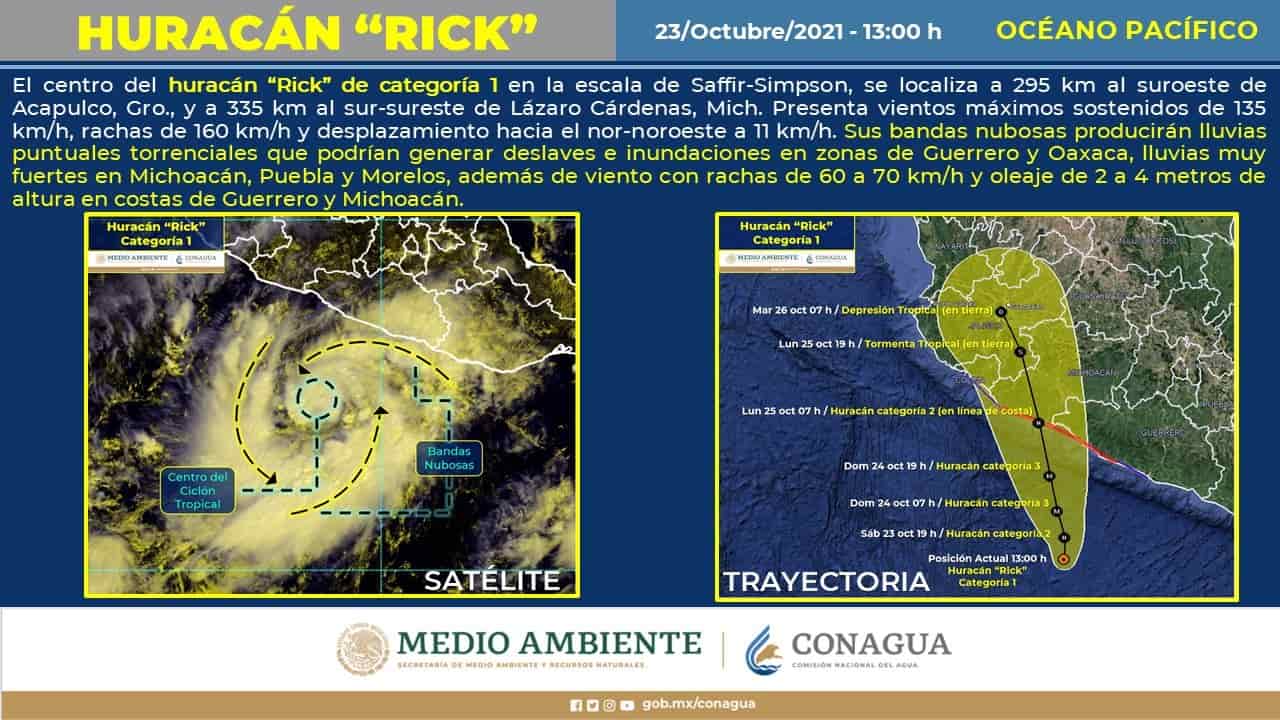Acapulco: Rick becomes a hurricane; expected to intensify to category 2 today
Hurricane Rick became a category 1 hurricane this Saturday and is expected to further intensify and impact at level two on Sunday night and early Monday between Zihuatanejo, Guerrero, and Lázaro Cárdenas, Michoacán.

Tropical Storm Rick became a category 1 hurricane this Saturday and is expected to continue intensifying and impact at level two on Sunday night and the first hours of Monday between Zihuatanejo, Guerrero, and Lázaro Cárdenas, Michoacán, warned the National Meteorological Service (SMN).
At 7 p.m. central Mexico time, the eye of the hurricane was located 265 kilometers south-southwest of Zihuatanejo, Guerrero, and 290 kilometers south of Lázaro Cárdenas, with maximum, sustained winds of 140 kilometers per hour and gusts of 165. It maintains a trajectory to the north-northwest at eight kilometers per hour.
Alejandra Méndez Girón, the coordinator of the SMN, said that "an acceleration" in the displacement of the phenomenon has been observed, which will affect the aforementioned states, as well as Oaxaca, Jalisco, and Colima.
In Jalisco, on Saturday afternoon, authorities from the three levels of government met to monitor the trajectory, evolution, and coordination actions, in addition to initiating the deployment of personnel to monitor riverbeds and vulnerable areas, informed the state government.
Nayarit is in turmoil; Pamela still ravaging the region
In Nayarit, the inhabitants of the north of the state have not yet been able to remove the mud that has formed a hard surface or is adhered to the walls of their houses, when authorities are calling them to be alert to the possibility that Rick could leave them with a lot of water between Monday and Tuesday of next week.
Given this forecast, the Mexican Army will continue in the seven municipalities affected by the passage of Pamela, which occurred on October 13.
Claudia Yesenia Mancinas, a single mother of five children and inhabitant of Los Sandovales, a town in the municipality of Acaponeta, Nayarit, cries with impotence when she remembers that three years ago, in 2018, she suffered the first major flood caused by Hurricane Willa in category 3 and overflowed the Acaponeta River, taking everything she had been able to buy in 30 years of living in that place.
She points out that since the construction of the Tepic-Villa Union highway, hurricanes have become devastating, and even though "I no longer want to live with this fear, with this uncertainty, I don't know where or how to go," she says as she wipes her tears with one hand and with the other she carves her little daughter's back.
The day Pamela hit this town, she recalled, "we grabbed blankets, two changes of clothes, important papers, the children's backpacks for school, and we left shaken, we left between 8 and 8:30 and the water arrived around 11:30 or 12", Claudia said. When she returned, she said that the water was over 3 meters high, it covered her entire house and on her roof, there are still countless branches and trunks left by the current.
A few meters away, members of the Army are digging their pickaxes to loosen the debris left by the current, shoveling up solid mud and throwing it into wheelbarrows. Two blocks away, a long line of victims waits to receive their breakfast, which consists of stew, tortillas, coffee, and cookies, all made by the military in the community kitchens. Every day the soldiers deliver a thousand rations of hot meals.




